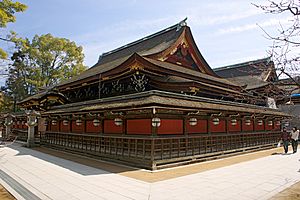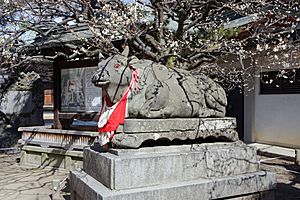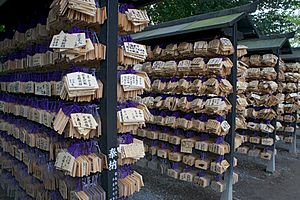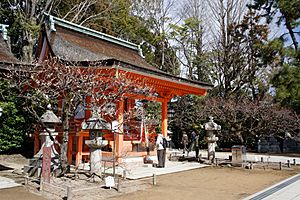Kitano Tenman-gū facts for kids
Quick facts for kids Kitano Tenmangū |
|
|---|---|

The honden, or main building.
|
|
| Religion | |
| Affiliation | Shinto |
| Deity | Sugawara no Michizane |
| Festival | Reitaisai (August 4th) |
| Type | Tenmangū |
| Location | |
| Location | Hakuraku-chō, Kamigyō-ku, Kyoto |
| Architecture | |
| Architectural style | Gongen-zukuri |
| Date established | 947 |
Kitano Tenmangū is a famous Shinto shrine located in Kamigyō-ku, Kyoto, Japan. It was first built in 947 to honor and calm the spirit of a very smart and important person named Sugawara no Michizane. Michizane was a top government official, a great scholar, and a talented poet. He was sent away from the capital because of tricky political games played by his enemies from the Fujiwara clan.
History of the Shrine
This shrine became very important to the Emperors of Japan during the early Heian period (794-1185). In 965, Emperor Murakami ordered that special messengers be sent from the palace to report important events to the kami (gods or spirits) who protected Japan. These messengers, called heihaku, first went to 16 different shrines.
Later, in 991, Emperor Ichijō added three more shrines to this special list, and Kitano Tenmangū was one of them. This showed how much the emperors respected and supported the shrine.
From 1871 to 1946, Kitano Tenmangū was officially recognized as one of the most important Shinto shrines supported by the government. It was ranked as a second-tier shrine. The buildings you see today were mostly built in the early 1600s.
Honoring Tenjin
The Kitano Tenmangū shrine was built to honor Sugawara no Michizane. In 986, Michizane was given the special title of a "God" and became known as "Tenjin". He is now seen as the kami (Shinto god) of education and learning.
Because of this, many students visit Kitano Tenmangū to pray for good luck and success in their studies, especially during exam times. The shrine can get very busy with students and school trips.
Plum Blossom Festival
The shrine grounds are filled with Michizane's favorite trees: red and white ume, or plum blossom trees. When these trees bloom, usually in late winter or early spring, the shrine becomes a very popular and crowded place.
The Plum Blossom Festival is held every year on February 25. This date marks the day Michizane passed away. This festival has been celebrated on the same day for about 900 years!
During the festival, there is an outdoor tea ceremony. Here, tea and traditional Japanese sweets called wagashi are served to many guests, sometimes as many as 3,000 people. This outdoor tea ceremony started in 1952 to celebrate the 1,050th anniversary of Michizane's death.
Images for kids
-
A maiko serving tea at the plum blossom festival.
See also
 In Spanish: Kitano Tenman-gū para niños
In Spanish: Kitano Tenman-gū para niños









